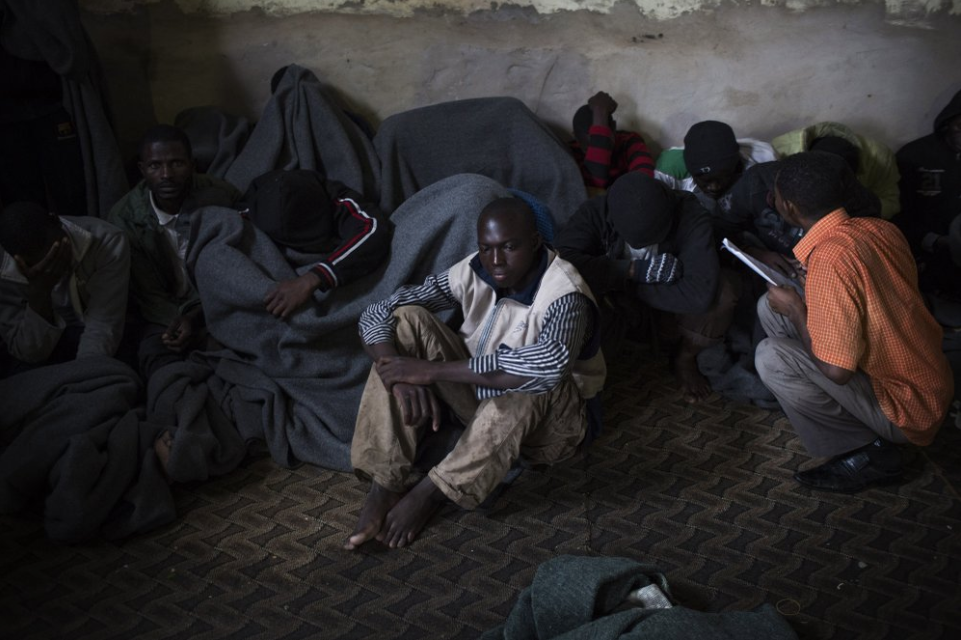TRIPOLI, Libya (AP) — The United Nations center in Libya was opened as an “alternative to detention,” a last, safe stop for migrants before they were resettled in other countries. Now, just a year later, it looks increasingly like the notorious Libyan lockups it was supposed to replace.
The facility is jam-packed with nearly 1,200 migrants — about twice the number it was built for — including hundreds who fled from abuse at other detention centers in hopes of sanctuary. Dozens of patients with tuberculosis languish in a room crammed with mattresses. Sewage is overflowing, and armed guards from a local militia have effectively turned the center into a prison.
Unable to cope, the U.N. last week offered migrants the equivalent of $112 each to leave, and warned that food, already down to emergency rations, would be cut off on Jan. 1 for unapproved arrivals.
“This is very dangerous because among us there are people who are malnourished,” said a 27-year-old Sudanese man who arrived at the center in July. “If they cut food, they won’t be able to stand it.”
He, like the rest of the nearly dozen migrants who spoke with The Associated Press from the compound, asked to withhold his name because of fears of retaliation. Libyan security officials and U.N. and other aid workers confirmed that the U.N. had lost control of the facility.
The conditions at the center underscore the predicament the U.N. finds itself in over migration. The U.N. has criticized the detention of migrants in Libya — a position it reiterated last month when Italy suggested the U.N. High Commissioner on Refugees run more centers as a solution to rampant abuse in Libyan prisons.
“UNHCR does not and will not run places of detention in Libya,” its spokesman, Charlie Yaxley, told the AP.
Yet that is effectively what the Tripoli facility has become.
“It’s not the best possible scenario,” acknowledged Jean-Paul Cavalieri, the head of the UNHCR in Libya.
Cavalieri lamented the chaos that has accelerated as migrants acting on their own escape other detention centers with torture, rape, slave labor and trafficking to what they hope will be UN protection. He said the UNHCR is glad they are free of detention but cannot handle them at its center, known as the Gathering and Departure Facility, where people supposed to be there for days now spend months stuck in a bureaucratic limbo.
Cavalieri also said there are fears of possible abuse at the UN center, including of young girls. U.N. staff now spend just four hours a day in the compound, migrants and Libyan officials say.
The situation has grown out of Europe’s outsourcing of migration to Libya. Europe has poured nearly 425 million euros into Libya since 2016 to keep migrants from reaching its shores — money that goes mostly to the U.N. and other aid agencies to improve conditions for migrants and Libyans displaced by the country’s civil war. The U.N. runs a vast operation within Libya, registering 40,000 refugees and asylum seekers, with about 6,000 inside the detention system and the rest ensconced in communities in Tripoli and beyond.
But dependence upon European funding and its increasingly restrictive migration policies have left the U.N. in the uncomfortable position of being the arbiter of horror stories. It is the U.N.’s job to decide who has suffered enough to get a coveted resettlement slot in another country.
Many end up waiting months, sometimes years — often in other detention centers — to learn their fate. The U.N. is now threatening to suspend asylum cases altogether for unauthorized migrants who refuse to leave its GDF facility.
The facility, like the UNHCR mission in Libya itself, was funded largely by European countries. The idea was that it would be operated by UNHCR, with cooperation from the Libyan government.
The situation was less than ideal from the outset, Cavalieri acknowledged. Delayed by months of negotiations, UNHCR ultimately agreed to a series of conditions from the Libyan government: armed guards within the compound and Interior Ministry militia at the gates, no freedom of movement for the refugees and asylum seekers, and a single Libyan “partner” for the various lucrative contracts inside.
Those conditions were never publicly spelled out. When the first group of refugees was resettled from the facility in December 2018, the UNHCR described it as “the first centre of its kind in Libya,” and said it was “intended to bring vulnerable refugees to a safe environment” while solutions were found. More than 2,300 people have passed through in the past year.
Most of the migrants at the U.N. center fled from worse and are torn between relief and fury — relief to have escaped Libya’s prisons alive, and fury at the impotence of the U.N., which they say lacks either the will or the power to make any meaningful decisions about their future, inside the center or out.
“They don’t have any humanity,” said a 15-year-old Eritrean who survived an airstrike on his detention center, fled to the U.N. facility, and is waiting to learn his fate.
“What shall we do?” he asked. “We have no options but to stay. Is there any news?”
Hinnant reported from Paris. Paolo Santalucia contributed from Rome.



